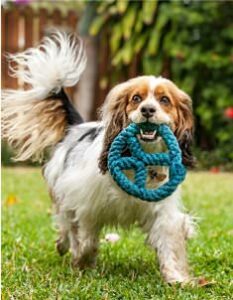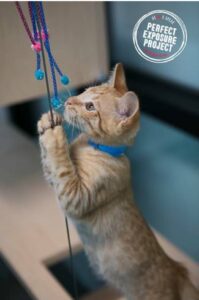I really don’t like getting my photo taken. Professional headshots, family photos, and even selfies with friends — it’s not always a natural-feeling experience to be the focus of attention. The pressure of the photographer staring at me, trying to figure out what pose doesn’t make me look 5lbs heavier, holding a smile for what feels like FOREVER… the entire process is uncomfortable.
However, every now and then someone captures a magical candid photo that just seemed to effortlessly happen. Sure, the photographer may have had the scene meticulously set, but I personally didn’t need to do anything. She said the exact thing at the right moment to elicit the exact expression she was hoping for.
And, you know what? I think we should strive for the same thing in our pet photography.
For most shelter animals, before they arrive for their photo, they have had a hellish few days. They were given up by their owners or were out on the streets, taken into a strange building with weird people, poked and prodded by a medical team, and then they were put into a cage next to more cages filled with unknown animals.
And now we want them to put on a calm, happy expression and pose for a photo.
Thankfully, by managing your photo environment, making the process playful and positive, and avoiding some stress triggers, we can make getting a great photo as easy and painless as possible.
Here are a few tips to help manage a safe, stress-free, and (relatively) effortless photo session.
Managing Your Environment
A lot of the “new arrivals” I photograph are naturally scared of the studio environment. The lights and the vinyl backdrop are just two new, suspicious things they feel wary of.

So let’s make it our responsibility to make their photography environment a little more welcoming. You can either:
- Avoid the studio altogether. Choose a more relaxing environment, especially one that allows the opportunity for play. For dogs, this can mean taking photos outside in a relatively-secluded area, and for cats, this could mean taking them into an enclosed area in which they can roam, play, and explore (with suitable lighting, of course). Some of the best photos I have ever taken were of dogs outside at play and cats engaging with their surroundings.
- Make your studio an oasis. For those of you who are blessed with an area you can use as a studio, make the space as welcoming as you can. Ensure the room is quiet, intimate (not a lot of people walking by), and is stocked with treats and toys to welcome each pet. You may even try calming music (Pet Care Music Therapy has playlists on Apple Music) or aromatherapy sprays/plugins like Feliway.A trick that has worked for me is bringing the pet’s bed/blanket from its cage into the studio with it so he/she has something familiar with which to take comfort.
Start Slow
Give the pet time to adjust before you begin snapping. If you have a lot of photos to take in a short amount of time, this may be difficult, but when a pet enters the room, try to start off quiet and reserved. Give the pet time to sniff and explore – maybe even quietly show him/her your camera.
If getting the animal focused requires you to increase the volume or the level of engagement, go for it. But never start off loud and then get quiet once you realize a pet is scared. It is very hard to get a scared animal to relax for a photo once it is stuck in an enclosed room with you without being given the time and space to calm down.
Make the Experience Playful and Positive
 Has this happened to you? A family member wants to take a photo of you. They ask you to strike a pose, then everyone gets quiet (too quiet), and it seems like it takes FOREVER for them to actually take the photo? In those few seconds of painful silence, you feel your face cramp and you may even get a little nervous.
Has this happened to you? A family member wants to take a photo of you. They ask you to strike a pose, then everyone gets quiet (too quiet), and it seems like it takes FOREVER for them to actually take the photo? In those few seconds of painful silence, you feel your face cramp and you may even get a little nervous.
But, have you ever posed for a photo while you’re giggling and chatting with the photographer the entire time? You almost forget the picture is being taken, and the photo turns out just as good — maybe better? Sure it may take a few extra shots to get the perfect photo, but it was a much more pleasurable experience, right? This method works just as well with pets.
While you don’t want the animal all riled up, speaking softly and gently to the animal throughout, reinforcing calm, happy behavior with treats or toys, and moving at a steady pace keeps the animal relaxed while still engaged.
You can still make noises and squeak toys to achieve the expression you may need if they like that stimulant, but keeping them relaxed yet engaged between photos helps make the process go by much smoother.
For Pets You’re Just Getting to Know, Avoid These Stressors
Unless you are very comfortable and familiar with a particular pet, you’ll want to avoid these common stress-inducers:
- Props or costumes. Most animals don’t like being dressed up. If you and your model are not comfortable around each other yet, never force an animal to pose with a prop or wear a costume.
- Flash. The momentary blindness that comes with a camera flash will scare pets that are not familiar with it. If you need additional light, opt for continuous lamps instead.
- Foot traffic. Nothing is more distracting to a pet (and a photographer) than watching people watch them! Opt for a private and removed area if possible.
- Rushing. While maintaining a quick and steady pace is fine, rushing a photo session often leads to exposing an animal to too much stimulation too quickly. This will just end up riling the pet up (either from excitement or fear) and will make your job harder in the long run.
Finally, always remember that you should NEVER force a scared animal to take a photo. If a pet is so scared that you’re having a hard time getting him/her out of the cage or into the photo studio, just put him/her back and try again tomorrow. You never want to risk a pet biting out of fear, and more often than not, you’ll only capture an expression of fear – and that won’t help your furry friend find a home!
I hope these photography tips have helped. For more tips, check out the HeARTs Speak EDU library.
Wishing you all a calm and stress-free week ahead!


[…] Understanding how to use your equipment is one of the best tips to have a stress-free photo session. […]